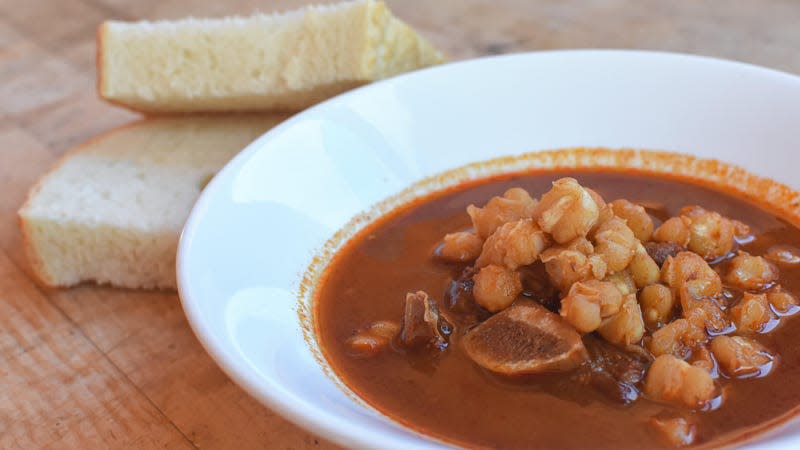If You Don’t Eat This in Albuquerque, You Haven’t Tasted New Mexico

When I first landed in Albuquerque, New Mexico, the cinnamon-colored adobe buildings looked like the rosy rocks of the Sandia Mountains embraced them. To call it a striking city is an understatement. The cacti and fluffy Pampas grass of the high desert combine with Pueblo-style buildings and busy, modern thoroughfares to create a distinct landscape that reflects both ancient indigenous history and contemporary American trends. Albuquerque is the kind of place that must be experienced on several levels at once. You have to go outside and explore the natural beauty, you have to connect with Pueblo culture, and right in between the two, you have to taste its flavors.
The chance to hop into a hot air balloon was the first thing that excited me about Albuquerque. Famous for the annual Albuquerque International Balloon Fiesta, the largest ballooning event in the world, the city is filled with hot air balloon pilots who launch rides all year round. Stable wind patterns and weather conditions make Albuquerque the perfect place for ballooning, so I headed out for a sunrise ride with Rainbow Ryders.
Read more
I climbed into the basket of a balloon splashed with the geometric symbols of the Indian Pueblo Cultural Center. Floating over the Rio Grande River Valley I glimpsed cranes and hawks flying through the sky, and as we approached the river, our pilot, Alfred, steered the balloon downward for a “splash and dash,” into the water and up into the air again.
Viewing the landscape from above helped emphasize the area’s natural beauty, and not just via balloon. Climbing through the desert skies and over canyons and forests up 10,378 feet via the Sandia Peak Tramway, it’s obvious why New Mexico is called the Land of Enchantment.
So much of Albuquerque’s culture is defined by its nature, a connection I learned about in detail at the Indian Pueblo Culural Center. Located on 80 acres and governed by the 19 New Mexico Pueblo communities, the center boasts a museum, galleries, library, traditional garden, restaurant, and an Indigenous-owned Starbucks, the first non-corporate-owned Starbucks in the country. The Pueblo Indians settled the land and have lived in the region for centuries under the Spanish, Mexican, and American governments.
“We like to bring people around our culture and dispel myths,” said Monique Fragua, COO of the Indian Pueblo Cultural Center. “We want people to know that we’re alive, we exist.”
Perhaps one of the most memorable ways to experience Pueblo culture is through its food. Famous for incorporating the “three sisters” of corn, beans, and squash, traditional dishes use these core ingredients in a variety of ways. When I sat down at the Indian Pueblo Kitchen, I was immediately treated to puffy, golden ovals of Pueblo oven bread. Traditionally baked in outdoor adobe ovens called hornos, the bread was dense and moist with a hint of sweetness. I devoured it and would have been satisfied with eating it alone, but I waited for the posole, a hominy stew often served alongside it.
The steaming bowl soon arrived, as did the scent of chiles and cumin. I dipped some bread into the thick liquid and savored the hearty flavor of beans and hominy spiked with chile spice.
“Stews and breads are usually eaten on on feast days and during traditional ceremonies,” Pueblo Indian Kitchen chef Davida Becenti (Diné) told me. “The secret to the bread making is to do it with love and compassion. The main ingredients for the stew are meat, red chile, and white corn that is grown from the field.”
Walking past the center’s garden filled with sprouting white, blue, and yellow corn plants, I felt full in multiple ways, having partaken of the city’s history and culture—and just a really good taste of Albuquerque.
Chef Becenti’s Posole Recipe
2 lbs. white hominy
2 lbs. pork, cut into 1-inch cubes
4 cloves garlic
3 bay leaves
1 tsp. cumin
2 Tbsp. dried Mexican oregano
1 lb. red chile pods
Dash of salt
2 Tbsp. oil
Boil 3 quarts of water; remove stems and seeds from red chile pods. Add chiles to water and let reduce for an hour. Add pods into blender along with 2 cups of the liquid and puree. (Reserve the remaining liquid in the pot.)
Add chile puree into pot with remaining liquid, then add the white hominy. Cook for 45 minutes on low heat.
In a saucepan, brown the pork, garlic, bay leaves, cumin, and oregano with two tablespoons of oil for at least 5 minutes.
Add pork and spices into boiling chile puree and hominy. Let simmer for 35 minutes on low heat until pork is soft, then serve.
More from The Takeout
Sign up for The Takeout's Newsletter. For the latest news, Facebook, Twitter and Instagram.

